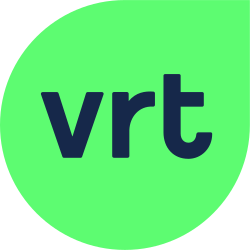Vlaamse Radio- en Televisieomroeporganisatie
|
|
|
|---|---|
| TV station ( public service ) | |
| Program type | Full program |
| reception | DVB-T , DVB-S , DVB-C , cable |
| Start of transmission | 1930 |
| language | Dutch |
| Seat | Brussels |
| List of TV channels | |
| Website | |
Vlaamse Radio- en Televisieomroeporganisatie ( VRT ; German “Flemish Radio and Television Organization” ) is a public broadcaster of the Flemish Community in Belgium, financed largely through taxes . From 1960 to 1998 the station was called Belgische Radio- en Televisieomroep ( BRT ; 1991–98 with an additional N for Nederlandstalige uitzendingen ); since 1998 VRT , which initially stood for "Vlaamse Radio- en Televisieomroep", and since 2009 for "Vlaamse Radio- en Televisieomroeporganisatie". The broadcaster produces radio and television programs in Dutch for Belgium.
history
Belgian radio stations of the 1930s |
As early as 1908, the engineer Robert Goldschmidt was experimenting with radio waves in Brussels. In 1913, speech and music were first transmitted via long wave in the royal garden in Laeken / Laken ; on March 28, 1914, a concert was broadcast for the royal family. At the beginning of the First World War, however , King Albert had the facility destroyed in order not to let it fall into German hands.
The beginnings of Dutch-language broadcasting in Belgium go back to Radio Antwerp , which was set up on an Antwerp church in 1926/27 , known as Radio Kerkske (“Radio Kirchlein”), and moved to Edegem in 1935 . The 1928 launched Flemish providers NV Radio ( "Radio-AG"), with effect from 1 February 1931, which has existed since 1922/24 French-language Radio Belgique for Nationaal Instituut voor de Radio-omroep (NIR) / Institut National Broadcasting (INR ), whose new medium wave transmitters are located in Veltem . In 1934 the shortwave broadcasts from Ruiselede for the Belgian Congo begin . In addition, there were 16 local stations in Belgium before the Second World War, 4 of which broadcast in Dutch (yellow in the map on the right). From 1940 to 1944, Belgian radio was controlled by National Socialist Germany ( Zender Brussel / Radio Bruxelles ), while the Belgian government-in-exile uses BBC broadcasters ( Radio België / Radio Belgique ) and in Léopoldville (1942 Belgian National Radio Omroep / Radio nationale belge ). After the war, the Wavre-Overijse broadcasting station was opened in 1952 and the television service in 1953. In 1960, NIR / INR became part of Belgische Radio- en Televisieomroep (BRT) / Radiodiffusion-Télévision belge (RTB), and in 1977 it was split into BRT (N), RTBF and BRF . From the 1970s to the 1990s, there was also terrestrial Belgian television for the Belgian armed forces in Germany . At the end of 2011, the international service Radio Vlaanderen Internationaal (RVi) was discontinued.
TV and radio offer
TV network
Analog and digital (DVB-T)
- Eén (previously VRT TV1)
- Canvas (previously BRTN TV, shared the slot with Ketnet from 1997 to 2006)
- Ketnet (children's program)
- OP12 (was a program for young viewers from 8 p.m. on the Ketnet slot, was discontinued due to austerity measures)
- SPORZA (was set up in 2004 as an additional sports channel for the Olympic Games, SPORZA is now the brand name for all sports broadcasts)
- BVN (satellite program from VRT and NPO )
Digital extra offers
- Eén + (digital extra offer from Eén)
- Canvas + (digital extra from Canvas)
- Net Gemist, (paid offer to watch the program again within 7 days of broadcasting)
- Ooit Gemist, (paid offer to view old series and programs).
- VRT Nu (VRT streaming offer, to watch the programs online)
Radio network
Analog and digital (FM and DAB)
- Radio 1 (News)
- Radio 2 (broadcasts twice a day from the regions: Vlaams-Brabant & Brussel , Limburg , Antwerp , Oost-Vlaanderen , West-Vlaanderen )
- KLARA (mainly classical music; 1961-2000 Radio 3)
- Studio Brussels (current and alternative music)
- MNM (pop music; 1992–2009 Radio Donna )
Digital extra radio stations (only on DAB and online)
- klara continuo
- nieuws +
- MNM hits
Online radio
- Ketnet hits
Internet portal
Via the vrt NWS platform , VRT offers multimedia content in all three national languages of Belgium. The Flemish language is the most extensive, but daily news, culture and reports are also distributed in German and French.
Switched off radio and TV channels
TV station
- 2014: OP12
- 2012: ketnet +
- 1997: TV2
Radio station
- Radio1 Classics (only online)
- Radio 2 De Topcollectie XL (only online)
- KLARA Jazz (only online)
- Studio Brussels Rock It! (only online)
- Radio donna (replaced by MNM)
- Donna hitbis (replaced by MNM Hits)
- Night radio
The international overseas service of VRT Radio Vlaanderen Internationaal was dissolved in 2009. This broadcast a Dutch program for listeners abroad on shortwave until October 2009 . The domestic program Radio 1 was broadcast on medium wave 927 kHz until December 31, 2011 .
The counterparts of the VRT are the RTBF in the French community of Belgium and the BRF in the German-speaking community .
Web links
- http://www.vrt.be/
- Latest news from Belgium (German-speaking service of the Vlaamse Radio- en Televisieomroeporganisatie )
Individual evidence
- ^ Raad van Bestuur en Gemeenschapsafgevaardigde. ( Memento of December 13, 2009 in the Internet Archive )
- ↑ Jaarverslag van het N. I. R., dienstjaar 1935 , p. 22.
- ↑ De geschiedenis van de Belgische radio: de eerste radiozenders
- ↑ Medium wave in Belgium ends on New Year's Eve. Retrieved December 26, 2018 . radioeins.de



